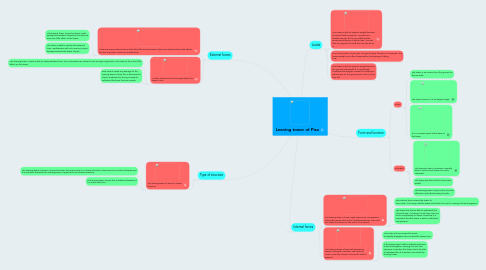
1. Internal forces
1.1. The leaning tower of Pisa might experience compression during the winter due to the cold temperatures. The cold will cause the stones on the south to compress.
1.1.1. This internal force causes the tower to lean more. If it is very cold the tower could lean too much, causing it to be dangerous.
1.1.2. The tower has too be able to withstand this internal force, if it doesn't it will lean over too much and possibly collapse. Therefore it is important that the tower is able to withstand compression.
1.2. The leaning tower of pisa will experience tension during the summer. The heat will cause cause the stones on the south side to expand.
1.2.1. This internal force causes the tower to slightly straighten, this corrects the towers lean.
1.2.2. If the tower wasn't able to withstand tension it would straighten, causing it to not lean anymore. Therefore the tower has to be able to withstand this if it wants to be called the leaning tower.
2. External forces
2.1. There are many external forces that affect the leaning tower of pisa.One external force that affects the leaning tower of pisa are earthquakes.
2.1.1. The leaning tower of Pisa has been made earthquake resistant, therefore this external force has little effect to the tower.
2.1.2. The tower is able to sustain this external force. Earthquakes will not cause any major damage towards the tower of pisa.
2.2. Another external force that might affect the tower is rain.
2.2.1. The leaning tower of pisa is able to easily withstand rain. This is because rain doesn't have enough magnitude. This external force had little effect on the tower.
2.2.2. Rain cannot cause any damage to the leaning tower of pisa, this is because the towers materials are strong enough to withstand the force that rain causes.
3. Type of structure
3.1. The leaning tower of Pisa is a Frame structure
3.1.1. The leaning tower of pisa is a frame structure, the reason why it is a frame structure is because it is not dome shaped and it is not solid, therefore the leaning tower of pisa has to be a frame structure.
3.1.2. The leaning tower of pisa has a skeleton,therefore it is a frame structure.
4. Loads
4.1. The tower is able to support weight because it was built with limestone. Limestone is flexible enough that it can withstand the pressures placed on it by the lean. It is also able to support the loads that are placed on it.
4.2. The leaning tower of pisa has to support many things such as people, the towers weight and other things without collapsing or falling over.
4.3. The tower is able to support weight because the ground underneath it is condensed, Therefore the weights causes the building to press down on the ground but it won't cause it to fall.
5. Form and function
5.1. Form
5.1.1. The tower is 55 meters from the ground on the low side.
5.1.2. The tower leans on a 3.99 degree angle
5.1.3. It is 2.4 meters apart at the base of the tower
5.2. Function
5.2.1. The leaning tower of Pisa was originally built to act as a bell tower, for Pisa's cathedral
5.2.2. The tower was also built to show Pisa's wealth
5.2.3. The leaning tower of pisa is also a tourist attraction and attracts many tourists.
